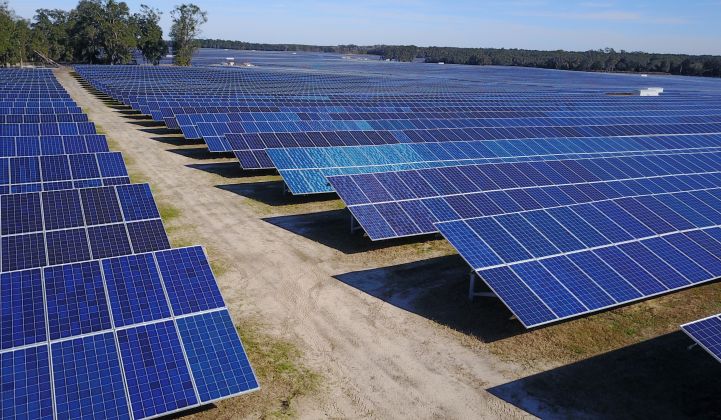Florida regulators unanimously approved Florida Power & Light’s proposed community solar program this week, rubber-stamping the build-out of nearly 1.5 gigawatts of utility-built solar in the state. The installations would nearly double the 2 gigawatts of community solar currently installed across the U.S.
Under the new program, called SolarTogether, FP&L will build 20 new solar plants (at 74.5 megawatts each) by mid-2021. Three-quarters of the capacity will go to commercial, industrial and government subscribers, with residential and small-business customers consuming the rest. Enrollment is slated to open March 17.
SolarTogether forms a significant part of FP&L’s plans to install 30 million solar panels by 2030, a goal that equates to more than 10 gigawatts. The utility, owned by NextEra Energy, said this week it has about 1.25 gigawatts of solar capacity already online, with SolarTogether helping "launch Florida into a leadership position for solar energy." FP&L’s recent solar announcements helped boost Florida to the top of utility-scale forecasts for a time in 2019, before the state was eclipsed by even bigger announcements in Texas and solar stalwart California.
Challenges to utility-led community solar
Despite skating to regulatory acceptance and receiving plaudits from many pro-clean energy groups, FP&L’s program was contentious at its outset amid ongoing questions about what should qualify as community solar.
Solar advocates wanted more benefits for customers, and developers generally reject utility-led community solar programs that don’t allow outside competition. Similar drama about program design and community benefits dogged a community solar program proposed by the Sacramento Municipal Utility District in California, which regulators also recently approved.
In the end, the groups challenging the Florida program — Vote Solar, Walmart and the Southern Alliance for Clean Energy — were able to secure an agreement from FP&L to allocate 37.5 megawatts to low-income customers. The settlement also guarantees those subscribers more immediate cost savings than other subscribers. For the latter group, subscription benefits won’t exceed costs for seven years.
After parties reached that agreement in October, citizen advocates at the state’s Office of Public Counsel questioned whether rate changes associated with the program were fair. Because SolarTogether is led by an investor-owned utility, ratepayers will bear some of its $1.79 billion cost. FP&L tried to quell those criticisms by sending 55 percent of the economic benefits of the program to subscribers and allocating the rest to non-subscribers.
In the end, members of the Florida Public Service Commission gave the program the green light despite the concerns. “This unique solar program is in the public interest of the state of Florida,” said PSC Chairman Gary Clark in a statement on the decision. “The new solar additions will serve to reduce the risk of higher fuel and emissions costs for all FP&L ratepayers.”
The utility estimated that the residential capacity allocated to the program could serve 74,500 customers if those subscribers purchase 100 percent of their annual usage. This week, FP&L said 150,000 residential and small-business customers had already expressed interest in the program. In the future, the utility could add further phases that would expand capacity.




